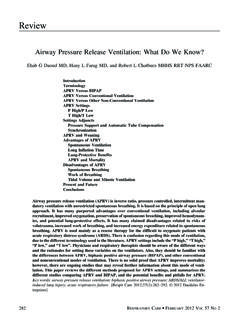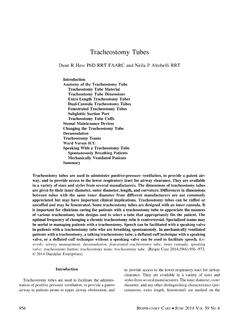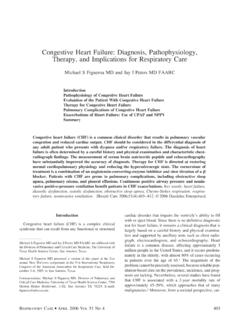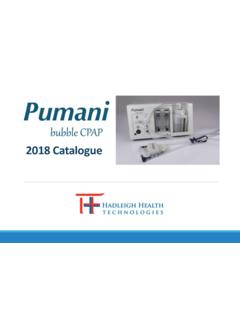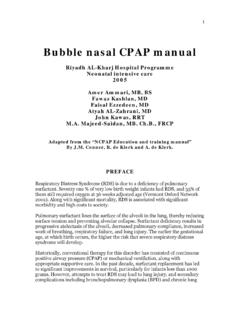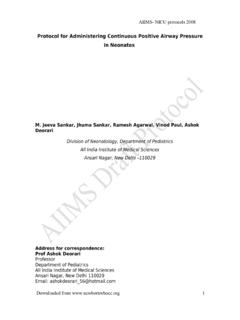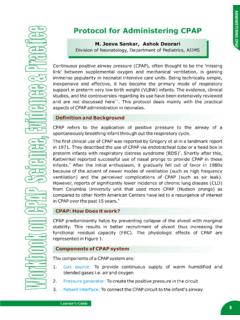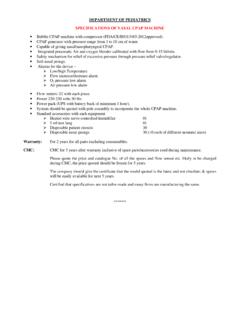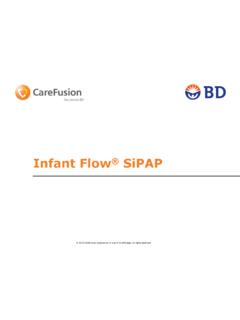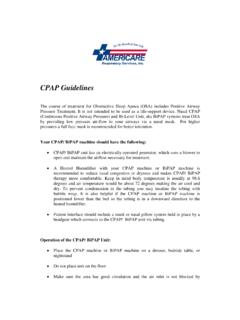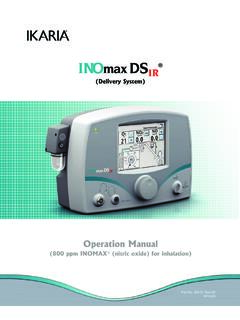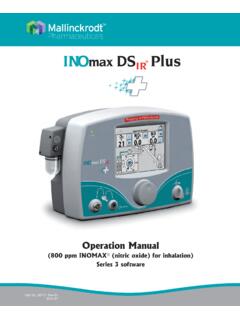Transcription of Nitric Oxide Delivery by Neonatal Noninvasive Respiratory ...
1 Nitric Oxide Deliveryby Neonatal Noninvasive Respiratory support DevicesRobert M DiBlasi RRT-NPS FAARC, Donna Dupras RRT-NPS,Christine Kearney RRT-NPS, Eddie Costa Jr RRT, and Jeffrey L Griebel RRTBACKGROUND: Inhaled Nitric Oxide (INO) has been used with heated and humidified high-flownasal cannula (HFNC), nasal cpap and several forms of Noninvasive ventilation (NIV). This studywas designed to evaluate the delivered dose of INO, level of NO2generation, and effect of net gasdelivery (addition of INO to the ventilator circuit gas removed for sampling) on lung pressure atdifferent NO doses during Noninvasive Respiratory support .
2 METHODS: An infant lung model wassupported with the different Noninvasive modes during INO therapy. NO and NO2were measuredfrom within the patient circuit of the Noninvasive devices and simulated Neonatal trachea at severalNO levels. Lung pressures were compared with and without INO and at several INO : Accuracy of NO Delivery was determined to be within the stated accuracy by themanufacturer with nasal cpap and NIV, but accuracy was compromised during HFNC. INO andNO2measured by the INOmax DSIR(Ikaria, Hampton, New Jersey) did not consistently reflect thedelivered dose of NO or formation of NO2across all types of Neonatal Noninvasive respiratorysupport.
3 Tracheal NO2levels were< ppm with all forms of Noninvasive support , except nasalintermittent mandatory ventilation at 40 ppm INO. Lung model mean airway pressures were mildlyaffected by gas sampling/ Delivery during combined INO therapy/HFNC at certain flows but re-mained stable with all other forms of Noninvasive support . CONCLUSIONS: Clinicians cannotalways assume that the set INO level results in a similar lung dose when using all forms of neonatalnoninvasive support . Clinical decisions regarding ways to improve INO Delivery may need toinclude changing settings or placing patients on a different form of Noninvasive support .
4 The NO2level delivered to the patient could be greater than the value recorded by the INO Delivery words: inhaled Nitric Oxide ; heated and humidified high-flow nasal cannula; Noninvasive ventilation;nasal cpap . [Respir Care 2015;60(2):1 . 2015 Daedalus Enterprises]IntroductionInhaled Nitric Oxide (INO) is a potent pulmonary vaso-dilator drug that is approved for use in term and near-terminfants ( 34 weeks of gestation) with acute hypoxic re-spiratory failure associated with pulmonary vast majority of INO research in the Neonatal popu-lation has been done in subjects receiving conventional orhigh-frequency mechanical ventilation.
5 Due to the im-proved understanding of the role of invasive ventilation inthe initiation of lung injury2,3and potential for increasingpulmonary vascular resistance,4there has been increasedinterest in combining Noninvasive ventilation (NIV) withINO DiBlasi, Ms Dupras, and Ms Kearney are affiliated with the SeattleChildren s Hospital, Seattle, Washington. Mr DiBlasi is also affiliated withthe Center for Developmental Therapeutics, Seattle Children s Hospital Re-search Institute, Seattle, Washington. Mr Costa and Mr Griebel are em-ployed by Ikaria, Hampton, New study was funded in part by Ikaria through donation of the drug anddelivery system.
6 The authors have disclosed no other conflicts of : Robert M DiBlasi RRT-NPS FAARC, Center for Devel-opmental Therapeutics, Seattle Children s Hospital Research Institute,1900 Ninth Avenue North, Seattle, WA 98101. E-mail: FEBRUARY2015 VOL60 NO21 Respiratory CARE Paper in Press. Published on November 11, 2014 as DOI: (C) 2015 Daedalus Enterprises ePub ahead of print papers have been peer-reviewed, accepted for publication, copy edited and proofread. However, this version may differ from the final published version in the online and print editions of Respiratory CAREC urrently, there is only one FDA-cleared Delivery de-vice available that maintains a consistent delivered INOdose regardless of the patient gas flow.
7 The device hasbeen validated by the manufacturer to be used with severalneonatal Noninvasive Respiratory support devices , includ-ingheatedandhumidifiedhigh-flowna salcannula(HFNC),nasal cpap (nasal cpap ), and several ventilators thathave been used for NIV. There have been sporadic reportsabout the combined clinical use of INO therapy deliveredthrough Noninvasive devices . Kinsella et al5first describednoninvasive INO Delivery through a nasal cannula follow-ing surgical repair in a select group of subjects with con-genital diaphragmatic hernia and late pulmonary hyperten-sion. There have also been a series of clinical studiesdescribing INO/ cpap in premature infants as part of atreatment strategy, and there were no reported safety con-cerns in these that are known to affect the concentration andfluctuation in the inspired concentration of INO includethe INO Delivery system, Respiratory support device type,settings and mode, circuit design, site of Delivery of INO,size of mixing chamber (if any)
8 In the patient circuit,concentration of inspired oxygen, and site and method ofINO INO is delivered during conven-tional or high-frequency oscillatory ventilation via an en-dotracheal tube, it can be assumed that the preset INO doseis similar to what the patient receives in the ,11 However, little is known about the compatibility, accu-racy, and safety of INO Delivery using the array of avail-able Noninvasive dioxide (NO2) is a toxic by-product that formswhen NO and O2gases are allowed to mix. This chemicalreaction can take place in the gas Delivery system or non-invasive Delivery device, the airway interface, and influencing the generation of NO2includeFIO2, dose of INO, and dwell time for INO and is more likely to form when using highFIO2in combination with high INO concentrations.
9 It isunclear whether the complicated physical gas flow path-ways of Neonatal Noninvasive support or the upper airwayfosters an environment wherein toxic levels of NO2canaccumulate and be inhaled into the lungs. Additionally,INO Delivery systems continuously sample gas, and it isunknown whether the subtraction of gas sampling from thepatient circuit or addition of INO gas can affect the pa-tient s mean airway pressure levels. As such, cliniciansmay be hesitant to use INO therapy in conjunction withnoninvasive Delivery study was designed to evaluate the delivered doseof INO, level of NO2generation, and effect of sampling onlung parameters at different NO doses in a realistic, spon-taneously breathing, Neonatal lung model using noninva-sive Respiratory support .
10 We hypothesized that there wouldbe no differences between: (1) tracheal INO and the presetINO level on the Nitric Oxide Delivery system, (2) NO2measured on the INO Delivery device and tracheal NO2;and (3) mean airway pressure in the lung model at baseline(no INO therapy) and at multiple INO (Hampton, New Jersey) reviewed the study pro-tocol to provide technical support where required. Theresearch was conducted by RMD, DD, and CK in thelaboratory of RMD at Seattle Children s Hospital in Wash-ington. All data collection, data analysis, and interpreta-tion of data were done by RMD, DD, and CK.

